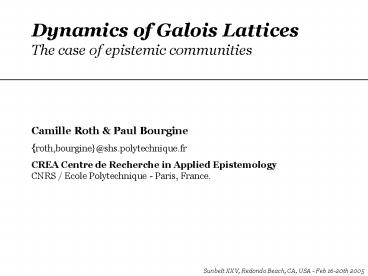Dynamics of Galois Lattices The case of epistemic communities
Title:
Dynamics of Galois Lattices The case of epistemic communities
Description:
Dynamics of Galois Lattices The case of epistemic communities Camille Roth & Paul Bourgine {roth,bourgine}_at_shs.polytechnique.fr CREA Centre de Recherche in Applied ... –
Number of Views:114
Avg rating:3.0/5.0
Title: Dynamics of Galois Lattices The case of epistemic communities
1
Dynamics of Galois LatticesThe case of epistemic
communities
Camille Roth Paul Bourgine roth,bourgine_at_shs.
polytechnique.fr CREA Centre de Recherche in
Applied EpistemologyCNRS / Ecole Polytechnique -
Paris, France.
Sunbelt XXV, Redondo Beach, CA, USA - Feb 16-20th
2005
2
ObjectiveEpistemic community taxonomy/dynamics
- Describe communities of knowledge, in particular
scientific communities, and their taxonomy e.g.
trends/subfields within a paradigm. - Epistemic community group of agents who share
a common set of topics, concerns, problems who
share a common goal of knowledge creation. - (Haas (1992), Cowan et al. (2000), Dupouet et al.
(2001)). - Definition used here an epistemic community
is the largest set of agents that share a given
concept set
3
Formal frameworkDefinitions
Epistemic community taxonomy/dynamics
- Consider the bipartite graph on R
- Intent of an agent set S all concepts used by
every agent in S - Epistemic group pair (S, C), where C is the
intent of S. - Epistemic community (based on a concept set C)
the maximal epistemic group based on C. - Dual notions
- examples (A,B,C,E, McB)
- (B,C, McB,EmG)
4
Formal frameworkGalois lattice
Epistemic community taxonomy/dynamics
- Good news the extent of the intent of an agent
set yields its epistemic community. - e.g. from C,D, whose intent is EmG, whose
extent is B,C,D, we get ? (B,C,D, EmG)
epistemic community - Pb there may be many such communities
5
Formal frameworkGalois lattice
Epistemic community taxonomy/dynamics
6
CategorizationGalois lattice
Epistemic community taxonomy/dynamics
- Hypotheses on scientific communities they are
structured (i) into fields, with common concerns,
and (ii) hierarchically, through
generalization/specialization relations. - We need a categorization method that allows
overlap. - The Galois lattice is the ordered set of all
epistemic communities (closed couples), provided
with the natural partial order on sets.
7
CategorizationGalois lattice
Epistemic community taxonomy/dynamics
basic-level
more general more specific
8
Galois latticeClosed couple relevance
empirical results
Epistemic community taxonomy/dynamics
- Try to find a relevant level of
generality/precision for the closed sets so that
the lattice is manageable. - Given the assumptions, first criterion fields
agent set size. - Very poor linguistic assumptions small
stop-word list, basic lemmatization, no
contextual processing, no homonymy, synonymy,
syllepsis, nominal groups - Computation of the lattice for a relation from
MedLine data on zebrafish, 1990-1995 (6 years).
9
Galois latticeEmpirical results
Epistemic community taxonomy/dynamics
Galois lattice on zebrafish community
density of closed sets against extension sizes
(author sets) as a proportion of agents of the
whole community (200 authors) (1800 concepts)
10
Galois latticeEmpirical results
Epistemic community taxonomy/dynamics
- Large ECs remarkable stylized fact of the data.
- Partial real lattice successfully checked by
domain experts
11
Galois latticeSelection
Epistemic community taxonomy/dynamics
- -gt Improve selection criteria, since agent set
size is - Over-selective Large yet less significant sets.
- Additional criterion Ratio between set and
superset sizes. - (2) Under-selective Small yet significant sets.
- Additional criterion Distance from the top.
12
Galois latticeSelection and dynamics
Epistemic community taxonomy/dynamics
- Three 6-year periods 90-95, 94-99 and 98-03.
Selection on 70 words. - Booming community from 1000 authors at the end
of 1995, to 9700 by 2004 (and 3700 in 1999). - Selection criteria
- (1) catch large communities Size/distance
attributes - (2) catch isolated communities Size/distance
number of sons
13
DynamicPartialLattice
Epistemic community taxonomy/dynamics
90-95
98-03
14
thanks
to be continued on http//camille.roth.free.fr
15
extra stuff
16
Formal frameworkDefinitions
Objective 1 - Epistemic community
taxonomy/dynamics
- More formally for X ? S, Y ? C,
- Properties
- and as such, it is a closure operation. X
is said closed iff XX. - Closed coupleA closed couple is thus an
epistemic community.
17
Galois latticeEmpirical results
Epistemic community taxonomy/dynamics
Decreasing cumulated frequencies
18
Categorization
Epistemic community taxonomy/dynamics
- Many epistemic communities how to categorize ?
- Computer science methods (euclidian distances
derivates, based more on computational than
sociological hypotheses) - Approaches stemming from sociology structural
balance, blockmodeling, structural cohesion... - pb 1 few hierarchical methods, and if so,
mostly trees or dendrograms - pb 2 they work fine on small sets































